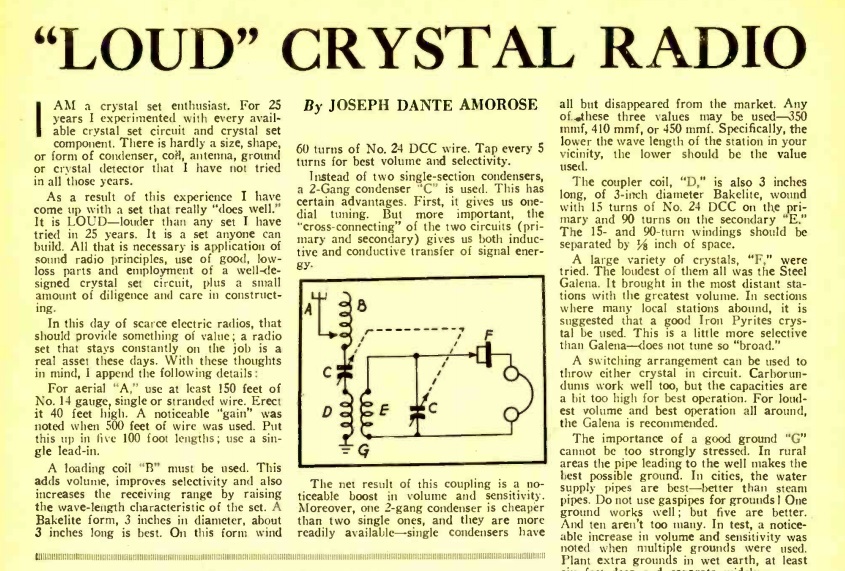 Seventy-five years ago this month, the September 1945 issue of Radio Craft carried these pointers by Joseph Dante Amorose for making a crystal set that did well. The author had been working on crystal sets for a quarter century, and he reports that this one was “LOUD–louder than any set I have tried in 25 years.” The article is not so much plans for a set, but a discussion of the attributes that made the set pull in the stations so well and so loudly.
Seventy-five years ago this month, the September 1945 issue of Radio Craft carried these pointers by Joseph Dante Amorose for making a crystal set that did well. The author had been working on crystal sets for a quarter century, and he reports that this one was “LOUD–louder than any set I have tried in 25 years.” The article is not so much plans for a set, but a discussion of the attributes that made the set pull in the stations so well and so loudly.
While the article hit the newstands after peace had been won, the author noted the value of a crystal set in the time of war in which the article was written: “In this day of scarce electric radios, that should provide something of value; a radio set that stays constantly on the job is a real asset these days.”
He began by noting that the aerial should be at least 150 feet of 14 gauge wire, but 500 feet showed noticeable gain. The antenna led to a loading coil, which the author said must be used to add volume and improve both selectivity and range. He found that 60 turns of number 24 wire on a 3 inch bakelite form worked best.
The ganged condenser not only saved money, since they were cheaper than two separate units, but also added gain since there was coupling between the two capacitors. The article included much discussion of the tuning coils, and then turned to the detector. The author recommended using multiple detectors and using a switch. He noted that the loudest crystal was steel galena. But when there were a lot of local stations, then iron pyrite would provide more selectivity. And for experimentation, a fixed detector should be used. When swapping out components, any change in volume would be very apparent if the detector was not adjustable.
An extremely good ground was required. In the country, the best was the pipe running to the well. In the city, it would be the cold water pipe, and not the steam pipe. He notes that one ground works well, but five are better, and ten isn’t too many.
Finally, he stressed the importance of using the best possible headphones, with a high impedance, and from a good manufacturer. In short, he stressed that you should use the best you can afford.
 It appears that the author copyrighted a booklet entitled “How to build the Amorose loud speaking crystal radio,” and in June 1946, he ran this classified ad in Popular Science to sell some of his writings.
It appears that the author copyrighted a booklet entitled “How to build the Amorose loud speaking crystal radio,” and in June 1946, he ran this classified ad in Popular Science to sell some of his writings.
